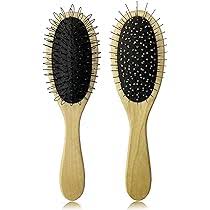How to Clean Wig Brushes and Combs

April 15, 2025
Wigs can be an essential part of personal style, a vital accessory for those dealing with hair loss, or even a fun way to try out different looks without commitment. Regardless of the reason for wearing a wig, proper care is crucial to ensure your wig remains beautiful and lasts for a long time.
One often-overlooked aspect of wig maintenance is cleaning the tools used to style them, such as wig brushes and combs. These tools can accumulate hair, styling products, dirt, and oils over time, making them less effective and potentially damaging to your wig. In this comprehensive guide, we’ll walk you through how to clean your wig brushes and combs thoroughly and maintain them for long-lasting use.
Why Is It Important to Clean Wig Brushes and Combs?
Before we dive into the “how,” let’s first understand why cleaning wig brushes and combs is so important. Wig brushes and combs are designed to help you detangle, style, and maintain your wig’s smooth, silky texture. Over time, however, these tools can become caked with oils, hair product residues, dirt, and other buildup. If not cleaned regularly, this residue can transfer to your wig and cause:
- Product buildup: Hairsprays, gels, and other styling products can build up on your brushes and combs, making them sticky and less effective.
- Damage to the wig fibers: Dirty tools can pull or tug on the wig fibers, causing unnecessary breakage, frizz, or tangles.
- Hygiene concerns: Bacteria and dirt on combs and brushes can transfer to the wig, affecting the wig’s condition and potentially causing scalp irritation.
- Reduced lifespan of tools: Over time, if you don’t clean your tools, they can degrade, become ineffective, or even damage your wig with repeated use.
Regular cleaning of your wig brushes and combs ensures that they work efficiently, prolong the life of your wigs, and maintain the integrity of the wig fibers.
Types of Wig Brushes and Combs
Before we discuss how to clean your wig brushes and combs, it’s essential to know that different brushes and combs are designed for different wig types. Not all wigs are created equal, and neither are the tools used to maintain them. Here are the most common types of brushes and combs you’ll come across when caring for your wig:
1. Wide-Tooth Comb
A wide-tooth comb is ideal for detangling both human and synthetic wigs without causing damage. It’s particularly effective for removing knots and tangles without pulling too hard on the wig fibers.
2. Wig Brush
Wig brushes are specifically designed to detangle and style wigs. They have soft, flexible bristles that prevent snagging and breakage. These brushes are often used for both synthetic and human hair wigs, though you should always check the manufacturer’s recommendations.
3. Pin Brush
The pin brush has long, thin, flexible pins that are great for smoothing out and detangling wigs. This type of brush works best on straight or slightly wavy wigs. It can also be used to style and add volume.
4. Teasing Comb
A teasing comb has fine teeth and is used for adding volume and teasing hair. It is useful when working with wigs that need a little extra lift or texture, especially when creating a full, voluminous look.
5. Rat Tail Comb
This comb has a long, pointed tail that allows for precise parting, sectioning, and styling. While it isn’t used for detangling, it’s great for adding detail when creating a more defined look with your wig.
6. Denman Brush
Denman brushes feature thick, firm bristles that are particularly suitable for curly and wavy wigs. These brushes are great for defining curls and maintaining the natural texture of the wig.
Materials and Tools You’ll Need to Clean Your Wig Brushes and Combs
Before you begin the cleaning process, gather the following materials and tools to ensure the best results.
Basic Cleaning Supplies
- Warm water: Never use hot water to clean your tools, as it can warp plastic combs or damage synthetic wigs.
- Mild shampoo: Use a gentle, sulfate-free shampoo. A baby shampoo or a specialized wig cleaner is also a good option.
- Baking soda: Baking soda is a gentle abrasive that helps to scrub away product buildup and oils without damaging the tools.
- Dish soap: Mild dish soap can be a great substitute for shampoo, especially for removing sticky residues.
- Rubbing alcohol: Rubbing alcohol is an effective solvent for removing stubborn product buildup on wig brushes and combs.
- Conditioner: Conditioner will help ensure that your tools stay soft and free of buildup after cleaning.
- Toothbrush or small cleaning brush: A toothbrush with soft bristles works well for getting into small areas of combs and brushes.
- Clean towel: You’ll need a towel to dry your cleaned tools.
Step-by-Step Guide to Cleaning Wig Brushes and Combs
Step 1: Remove Hair from Your Tools
The first and most crucial step in cleaning your wig brushes and combs is to remove any hair that’s tangled in the bristles or teeth. Use your fingers or a specialized tool, like a plastic comb or toothpick, to pull out the hair carefully.
For brushes, gently pull the strands of hair free, ensuring you don’t damage the bristles. For combs, gently run a toothpick between the teeth to remove hair strands that are stuck in the gaps.
Once all the hair is removed, proceed to the next step.
Step 2: Prepare a Cleaning Solution
Fill a small basin with warm water. Add a few drops of your mild shampoo or dish soap into the water. If your brushes have a lot of buildup or sticky residues, you can add a teaspoon of baking soda to the water to help loosen grime and oil.
Stir the mixture gently until the solution is well blended.
Step 3: Soak the Brushes and Combs
your wig brushes and combs in the cleaning solution. Let them soak for 10 to 15 minutes, allowing the solution to break down product buildup, oils, and dirt
.
- Synthetic wig brushes: If your brush is made of synthetic material, it may not require as much soaking time, but ensure it’s fully submerged.
- Human hair wig brushes: Brushes with human hair bristles can be more delicate, so don’t let them soak too long. Instead, opt for spot cleaning to avoid loosening any glue or adhesives.
Step 4: Scrub the Brushes and Combs
After the tools have soaked for a while, take your toothbrush or small cleaning brush and gently scrub the bristles and teeth. Focus on areas with visible buildup, such as around the base of the bristles or between the comb’s teeth.
For wig brushes, use small, circular motions to avoid damaging the brush fibers. Be gentle and avoid harsh scrubbing, which could cause bristles to fall out or bend.
Step 5: Rinse and Repeat If Necessary
Rinse your tools thoroughly under warm running water. Ensure that no shampoo or soap residue is left behind, as this could cause buildup the next time you use your brushes and combs.
If the brush or comb still has residue after rinsing, repeat the cleaning process. Use the toothbrush to scrub again, then rinse thoroughly.
Step 6: Dry Your Brushes and Combs
After rinsing, gently shake off excess water and lay the tools flat on a clean towel to air dry. Never dry your brushes or combs directly under sunlight, as the heat may damage the materials.
You can also use a clean towel to pat the bristles or teeth dry. Be sure to allow the tools to dry completely before using them again to avoid transferring moisture to your wig.
Step 7: Condition (Optional)
For combs and brushes with excessive buildup or sticky residue, you may want to follow up the cleaning process with a gentle conditioner. Apply a small amount of conditioner to the bristles or teeth, leave it on for a few minutes, and then rinse it thoroughly. Conditioner helps maintain the softness and flexibility of the bristles or teeth and prevents product buildup from reoccurring.
Additional Tips for Maintaining Wig Brushes and Combs
- Regular cleaning: Clean your wig brushes and combs regularly—ideally once a month or after each use, depending on how often you style your wig. If you use styling products daily, you may need to clean them more often.
- Store tools properly: Always store your brushes and combs in a dry, clean place to prevent dirt and moisture buildup.
- Use the right tool for the right wig: Always ensure that you’re using the appropriate tool for the wig type. For example, use a wide-tooth comb for detangling curly wigs and a soft-bristled wig brush for straight wigs.
- Be gentle: Always use a gentle hand when styling and cleaning your wig brushes. Rough handling can damage both the tools and your wig.
Keeping your wig brushes and combs clean is an essential part of maintaining the health and beauty of your wig. Regular cleaning helps prevent buildup, reduces damage to the wig fibers, and ensures your tools remain effective for a long time. By following the steps outlined in this guide, you can keep your wig brushes and combs in top condition, which will ultimately contribute to the longevity and quality of your wigs.
Remember, the condition of your wig styling tools reflects the care you put into your overall wig maintenance routine. Clean tools mean a longer-lasting, healthier wig, so don’t neglect them.
